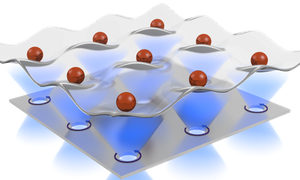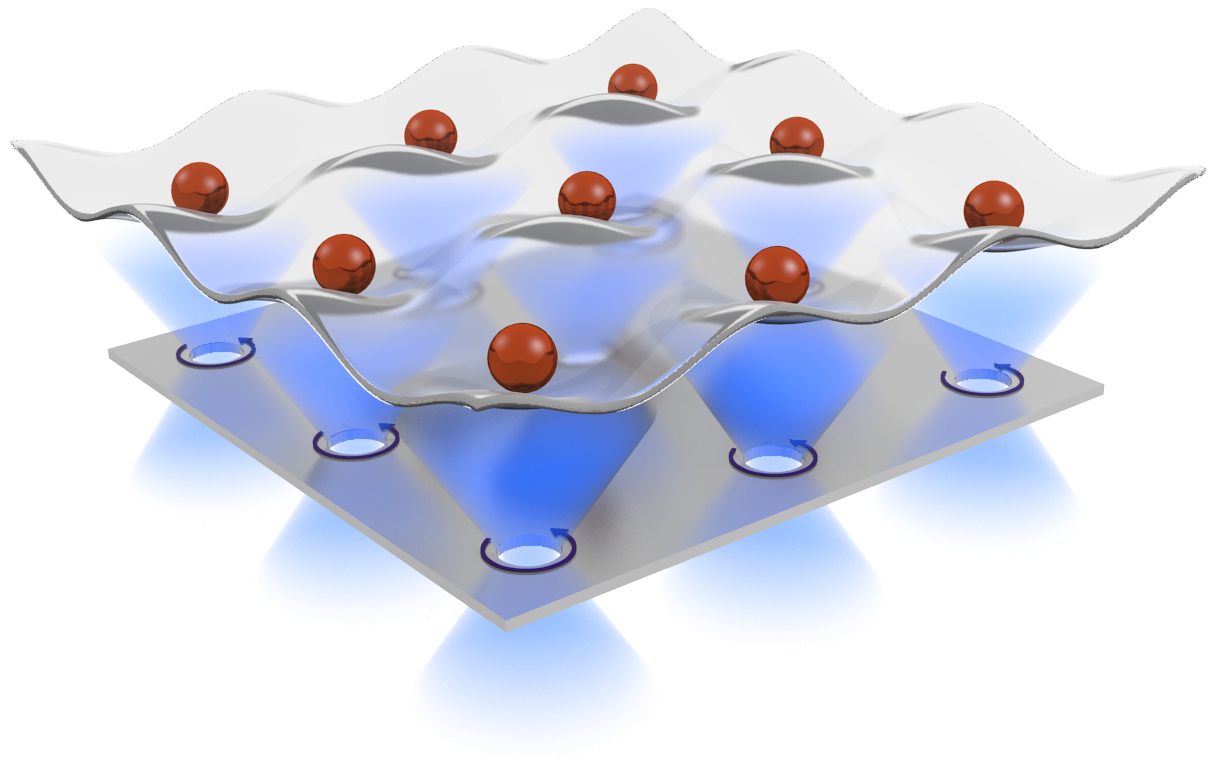Superconductor as Nanolattice of Atom Traps
Two-dimensional arrays of atoms trapped by lasers have become a widely-used technique to test quantum mechanics and build primitive quantum computers. Now a team writing in Physical Review Letters proposes to trap such an array with a magnetic field pattern produced by a perforated superconducting sheet. The system could hold atoms much closer together than optical trapping methods, potentially making it advantageous for certain kinds of quantum computing.
An optical lattice is an arrangement of crisscrossed laser beams that creates a periodic two-dimensional array of standing waves. Ultracold atoms are drawn into the minima of this field pattern, whose hills and valleys resemble an egg carton. The atoms can also hop, by quantum tunneling, from one valley to an adjacent one. Such a system can model phenomena in condensed matter physics because the array is akin to the atomic lattice in a crystal. But a crystal’s behavior is often too complex to solve by conventional computing, and an optical lattice can be a quantum computer or “simulator” that reveals those behaviors directly.
In a standard optical lattice, the separation between the atoms cannot be much smaller than the wavelength of light involved—typically hundreds of nanometers. But there are advantages to squeezing the atoms closer together, explains Oriol Romero-Isart of the Institute of Quantum Optics and Quantum Information in Innsbruck, Austria. At closer range, interactions between atoms are stronger, he says, so they are less influenced by external disturbances. Tunneling is also easier and therefore more frequent. The result should be a faster, more stable quantum simulator.
To trap atoms more closely together, Romero-Isart and his colleagues—a team led by Juan Ignacio Cirac of the Max Planck Institute for Quantum Optics in Garching, Germany—propose using purely magnetic fields. They start by imagining a sheet, some tens of nanometers thick, made of a type II superconductor. An applied magnetic field can penetrate such a material only in the form of so-called vortices that pass through the sheet at a set of isolated locations. Researchers can create a desired magnetic pattern by piercing the superconducting sheet with roughly 10-nanometer-wide holes that fix the vortices in place, even after the external field is removed. The upward-pointing field above the sheet will vary in intensity across any horizontal plane, with hills and valleys reflecting the arrangement of the vortices. An atom with a magnetic moment would move horizontally to a place where the field is weakest. In the vertical direction, however, the field strength will diminish with height, so an atom would simply drift upward. To create an atom trap above each vortex, the team proposes adding an externally-applied, uniform field that points down. The field would be strong enough to reverse the net field direction at some distance above the sheet but not strong enough to create more vortices. The point where the field goes through zero would be a stable resting place for an atom, provided that its magnetic moment is aligned exactly opposite to the field direction. To prevent the trapped atom from flipping its magnetic orientation, the team suggests using a standard technique that involves an additional, time-varying, horizontal magnetic field.
This arrangement, Romero-Isart and his colleagues say, is a precise analogue to an optical lattice of atoms trapped by lasers. The magnetic field creates a similar pattern of hills and valleys (in energy) that can trap atoms but can also allow them to occasionally tunnel from one trap to the next. The researchers say that this system could potentially improve the performance of quantum simulators. But in addition, they say that the ability to choose the geometrical arrangement of the traps by choosing the hole placement offers a new way to manipulate the lattice properties and possibly observe new behaviors of cold atoms in lattices.
Rainer Dumke of Nanyang Technological University in Singapore says that the new proposal is a “potentially groundbreaking approach” for which experimental realization is likely feasible. He adds that the details of implementation specified by the team allow them to show that noise and other disturbances should be much smaller than in an optical lattice.
–David Lindley
David Lindley is a freelance science writer, now retired. His most recent book is The Dream Universe: How Fundamental Physics Lost Its Way (Penguin Random House, 2020).





